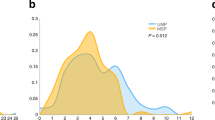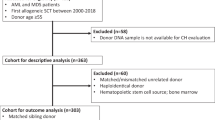Abstract
Minor histocompatibility Ags (mHags) have been implicated in the pathogenesis of GVHD after allogeneic hematopoietic stem cell transplantation (HSCT). Uridine diphospho-glucuronosyltransferase 2B17 (UGT2B17) gene deletion may act as a mHag and its association with acute GVHD (aGVHD) has been described. We retrospectively studied the clinical impact of a UGT2B17 mismatch in a cohort of 1127 patients receiving a HSCT from an HLA-identical sibling donor. UGT2B17 mismatch was present in 69 cases (6.1%). Incidence of severe aGVHD was higher in the UGT2B17 mismatched pairs (22.7% vs 14.6%), but this difference was not statistically significant (P: 0.098). We did not detect differences in chronic GVHD, overall survival, relapse-free survival, transplant-related mortality or relapse. Nevertheless, when we analyzed only those patients receiving grafts from a male donor (616 cases), aGVHD was significantly higher in the UGT2B17 mismatched group (25.1% vs 12.8%; P: 0.005) and this association was confirmed by the multivariate analysis (P: 0.043; hazard ratio: 2.16, 95% confidence interval: 1.03–4.57). Overall survival was worse for patients mismatched for UGT2B17 (P: 0.005). We conclude that UGT2B17 mismatch has a negative clinical impact in allogeneic HSCT from HLA-identical sibling donors only when a male donor is used. These results should be confirmed by other studies.
This is a preview of subscription content, access via your institution
Access options
Subscribe to this journal
Receive 12 print issues and online access
$259.00 per year
only $21.58 per issue
Buy this article
- Purchase on Springer Link
- Instant access to full article PDF
Prices may be subject to local taxes which are calculated during checkout

Similar content being viewed by others
References
Beaulieu M, Levesque E, Tchernof A, Beatty BG, Belanger A, Hum DW . Chromosomal localization, structure, and regulation of the UGT2B17 gene, encoding a C19 steroid metabolizing enzyme. DNA Cell Biol 1997; 16: 1143–1154.
Hum DW, Belanger A, Levesque E, Barbier O, Beaulieu M, Albert C et al. Characterization of UDP-glucuronosyltransferases active on steroid hormones. J Steroid Biochem Molec Biol 1999; 69: 413–423.
Gallagher CJ, Balliet RM, Sun D, Chen G, Lazarus P . Sex differences in UDP-glucuronosyltransferase 2B17 expression and activity. Drug Metab Dispos 2010; 38: 2204–2209.
Wilson W 3rd, Pardo-Manuel de Villena F, Lyn-Cook BD, Chatterjee PK, Bell TA, Detwiler DA et al. Characterization of a common deletion polymorphism of the UGT2B17 gene linked to UGT2B15. Genomics 2004; 84: 707–714.
Xue Y, Sun D, Daly A, Yang F, Zhou X, Zhao M et al. Adaptive evolution of UGT2B17 copy-number variation. Am J Hum Genet 2008; 83: 337–346.
Jakobsson J, Ekstrom L, Inotsume N, Garle M, Lorentzon M, Ohlsson C et al. Large differences in testosterone excretion in Korean and Swedish men are strongly associated with a UDP-glucuronosyl transferase 2B17 polymorphism. J Clin Endocr Metab 2006; 91: 687–693.
Murata M, Warren EH, Riddell SR . A human minor histocompatibility antigen resulting from differential expression due to a gene deletion. J Exp Med 2003; 197: 1279–1289.
Terakura S, Murata M, Warren EH, Sette A, Sidney J, Naoe T et al. A single minor histocompatibility antigen encoded by UGT2B17 and presented by human leukocyte antigen-A*2902 and -B*4403. Transplantation 2007; 83: 1242–1248.
Terakura S, Murata M, Nishida T, Emi N, Akatsuka Y, Riddell SR et al. A UGT2B17-positive donor is a risk factor for higher transplant-related mortality and lower survival after bone marrow transplantation. Br J Haematol 2005; 129: 221–228.
McCarroll SA, Bradner JE, Turpeinen H, Volin L, Martin PJ, Chilewski SD et al. Donor-recipient mismatch for common gene deletion polymorphisms in graft-versus-host disease. Nat Genet 2009; 41: 1341–1344.
Spierings E, Drabbels J, Hendriks M, Pool J, Spruyt-Gerritse M, Claas F et al. A uniform genomic minor histocompatibility antigen typing methodology and database designed to facilitate clinical applications. PLoS One 2006; 1: e42.
Goulmy E . Human minor histocompatibility antigens: new concepts for marrow transplantation and adoptive immunotherapy. Immunol Rev 1997; 157: 125–140.
Warren EH, Gavin M, Greenberg PD, Riddell SR . Minor histocompatibility antigens as targets for T-cell therapy after bone marrow transplantation. Curr Opin Hematol 1998; 5: 429–433.
Jervis S, Collins P, Tate D, Foster L, Bowman V, Adhern C et al. Increased severity of acute graft versus host disease as a result of differential expression following a homozygous gene deletion. Int J Immunogenet 2013; 40: 116–119.
Martínez-Bravo MJ, Calderón-Cabrera C, Márquez-Malaver FJ, Rodríguez N, Guijarro M, Espigado I et al. Mismatch on glutathione S-transferase T1 increases the risk of graft-versus-host disease and mortality after allogeneic stem cell transplantation. Biol Blood Marrow Transplant 2014; 20: 1356–1362.
Spierings E, Kim YH, Hendriks M, Borst E, Sergeant R, Canossi A et al. Multicenter analyses demonstrate significant clinical effects of minor histocompatibility antigens on GvHD and GvL after HLA-matched related and unrelated hematopoietic stem cell transplantation. Biol Blood Marrow Transplant 2013; 19: 1244–1253.
Acknowledgements
This work has been partially financed by grants PI11/01690 and PI14/01646 from the Instituto de Salud Carlos III, co-financed by FEDER (Fondo Europeo de desarrollo regional) and by grant MTV3/120210 from Fundació Marató TV3.
Author information
Authors and Affiliations
Consortia
Corresponding author
Ethics declarations
Competing interests
The authors declare no conflict of interest.
Additional information
Supplementary Information accompanies this paper on Bone Marrow Transplantation website
Supplementary information
Rights and permissions
About this article
Cite this article
Santos, N., Rodríguez-Romanos, R., Nieto, J. et al. UGT2B17 minor histocompatibility mismatch and clinical outcome after HLA-identical sibling donor stem cell transplantation. Bone Marrow Transplant 51, 79–82 (2016). https://doi.org/10.1038/bmt.2015.207
Received:
Revised:
Accepted:
Published:
Issue Date:
DOI: https://doi.org/10.1038/bmt.2015.207
This article is cited by
-
SNPs and prognosis of GvHD before HCT: any progress?
Bone Marrow Transplantation (2016)



